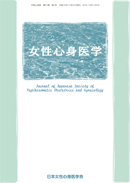
- Issue 3 Pages 177-
- Issue 2 Pages 119-
- Issue 1 Pages 29-
- |<
- <
- 1
- >
- >|
-
[in Japanese]2019Volume 24Issue 2 Pages 119-120
Published: 2019
Released on J-STAGE: January 15, 2020
JOURNAL FREE ACCESSDownload PDF (157K)
-
[in Japanese]2019Volume 24Issue 2 Pages 142
Published: 2019
Released on J-STAGE: January 15, 2020
JOURNAL FREE ACCESSDownload PDF (87K) -
Maiko HIRAIDE2019Volume 24Issue 2 Pages 144-148
Published: 2019
Released on J-STAGE: January 15, 2020
JOURNAL FREE ACCESSDownload PDF (435K)
-
Mie IZUMI, Emiko MANABE, Sayo UEMATSU, Ayako WATANABE, Kouichi IWASA2019Volume 24Issue 2 Pages 149-156
Published: 2019
Released on J-STAGE: January 15, 2020
JOURNAL FREE ACCESS【Purpose】This study was planed to observe the change of autonomic nerve activity from pregnancy until the puerperium.
【Method】Autonomic nerve activity and questionaire survey on the character were investigated in early, mid, and late pregnancy. One-way repeated measures of variance analysis was performed to examine the time-dependent change of the autonomic nerve activity statistically, and Bonferroni’s method was used for a post-hoc test.
【Results】Sixty three pregnant women with normal pregnant course was recruited as the subjects. Component coefficient of variance high-frequency, an index of parasympathetic activity, was significantly lower in late than in early pregnancy (p=.004), significantly higher at the puerperium period than in late pregnancy (p=.041). Low-frequency / high-frequency, as an indicator of sympathetic activity and component coefficient of variance R-R as an index of total autonomic activity were not significantly changed from pregnancy to puerperium period. Heart rate increased with pregnancy but decreased in puerperium.
【Discussion】The sympathetic nervous activity and total autonomic nerve activity did not change, but the parasympathetic nerve decreased with pregnancy. Heart rate tended to increase with pregnancy. As the circulation blood flow rate increases with pregnancy, the suppression of parasympathetic activity and heart rate increase may be occured to maintain cardiac output. Parasympathetic activity decreased during pregnancy, and increased during the puerperal period. At the same time, heart rate which increased during pregnancy decreased. From these facts, autonomic nerve activities changed to maintain homeostasis in response to physiological changes during each phase of pregnancy and in the puerperal period.
View full abstractDownload PDF (499K)
- |<
- <
- 1
- >
- >|